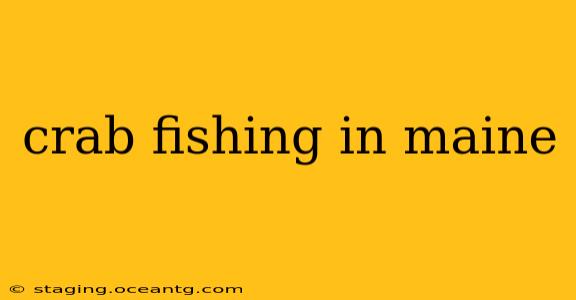Maine's rugged coastline and chilly waters are home to a thriving crab population, making it a popular destination for both commercial and recreational crab fishing. This guide delves into the intricacies of crab fishing in Maine, covering regulations, techniques, and the unique challenges and rewards this activity offers.
What Types of Crabs Can You Catch in Maine?
Maine's waters boast several crab species, but the most commonly targeted are Jonah crabs and rock crabs. Jonah crabs are larger and considered a delicacy, commanding higher prices in the market. Rock crabs are smaller and more abundant, often used for bait or personal consumption. Understanding the differences is crucial for legal and successful fishing.
When is the Best Time to Crab in Maine?
The best time for crab fishing in Maine generally falls during the cooler months, from late spring to early fall. Water temperatures play a significant role; crabs are more active in the cooler water. However, specific seasons and regulations vary depending on the type of crab and the location within Maine. Always check the most up-to-date regulations from the Maine Department of Marine Resources (DMR).
What are the Regulations for Crab Fishing in Maine?
Maine has strict regulations in place to protect its crab populations. These regulations cover:
- Trap Limits: The number of traps you can deploy is restricted, varying depending on license type and location.
- Size Limits: There are minimum size requirements for crabs you can keep. Crabs smaller than the legal limit must be returned to the water unharmed.
- Season Dates: Specific seasons are established for each crab species to protect breeding populations.
- Licensing: You'll need a valid fishing license to participate in recreational crab fishing in Maine. Commercial crab fishing requires additional permits and licenses.
It's crucial to consult the Maine DMR website for the most current and accurate regulations before embarking on your crab fishing adventure. Ignoring these regulations can lead to hefty fines.
What are the different types of crab traps used in Maine?
Maine crab fishermen utilize various traps, but the most common are traditional wire traps, often baited with fish or other attractive scents. The design allows crabs to enter but makes it difficult to exit. The specific design and materials used can vary, depending on personal preference and fishing conditions.
Where are the best places to crab in Maine?
Numerous locations along Maine's coast offer excellent crab fishing opportunities. Popular spots include Casco Bay, Penobscot Bay, and the waters around Monhegan Island. However, success hinges on factors like water depth, bottom type, and current conditions. Local knowledge and experience greatly enhance your chances of a fruitful haul.
How do I prepare my catch?
Properly preparing your crab catch is essential to maintain freshness and quality. Immediately after landing, crabs should be cooled quickly, typically by placing them in an ice slurry. You can then prepare your crab in various ways, including steaming, boiling, or grilling. Recipes abound online, showcasing the delicious versatility of Maine crabs.
What gear and equipment do I need for crab fishing in Maine?
Beyond the traps themselves, successful crab fishing in Maine requires the appropriate gear and equipment, including:
- Boat (if fishing from a boat): A stable boat suitable for navigating Maine's waters.
- Bait: Fish or other suitable attractants to lure crabs into your traps.
- Measuring Gauge: A tool to ensure compliance with size regulations.
- Gloves: To protect your hands from sharp crab shells.
- Rope and Buoys: To mark your traps and retrieve them safely.
Crab fishing in Maine is a rewarding experience that offers a connection with the state's rich maritime heritage. However, respect for the environment and adherence to regulations are paramount to ensuring the sustainability of this valuable resource for generations to come. Always consult the Maine Department of Marine Resources (DMR) for the latest information and regulations before you go.
